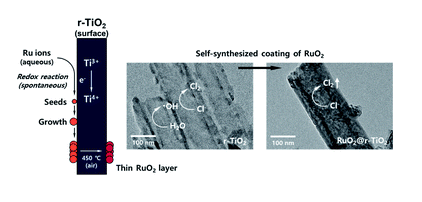Publication
Advanced Redox Technology Lab
Publication
Advanced Redox Technology Lab
Journal papers
Recently, reduced TiO2 nanotube arrays via electrochemical self-doping (r-TiO2) are emerging as a good alternative to conventional dimensionally stable anodes (DSAs) due to their comparable performance and low-cost. However, compared with conventional DSAs, they suffer from poor stability, low current efficiency, and high energy consumption. Therefore, this study aims to advance the electrochemical performances in the chlorine evolution of r-TiO2 with a thin RuO2 layer coating on the nanotube structure (RuO2@r-TiO2). The RuO2 thin layer was successfully coated on the surface of r-TiO2. This was accomplished with a self-synthesized layer of ruthenium precursor originating from a spontaneous redox reaction between Ti3+ and metal ions on the r-TiO2 surface and thermal treatment. The thickness of the thin RuO2 layer was approximately 30 nm on the nanotube surface of RuO2@r-TiO2 without severe pore blocking. In chlorine production, RuO2@r-TiO2 exhibited higher current efficiency (∼81.0%) and lower energy consumption (∼3.0 W h g−1) than the r-TiO2 (current efficiency of ∼64.7% of and energy consumption of ∼5.2 W h g−1). In addition, the stability (ca. 22 h) was around 20-fold enhancement in RuO2@r-TiO2 compared with r-TiO2 (ca. 1.2 h). The results suggest a new route to provide a thin layer coating on r-TiO2 and to synthesize a high performance oxidant-generating anode.
